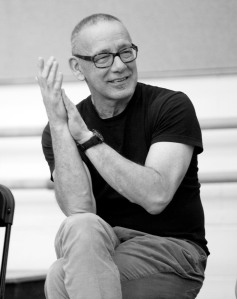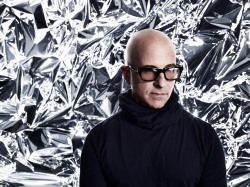We’re excited that New York-based Camille A. Brown & Dancers opens this Thursday night, November 5, for a three-night run at The Dance Center.
Below we’re posting two items that offer some advance information and background on Camille’s work and Black Girl: Linguistic Play, the 55 minute piece her company will perform with us. First you’ll see our program notes (contributed by faculty member Raquel Monroe), and then a valuable resource guide from Camille on the social dance forms that BG:LP references. We encourage you to give these a read this week, and come prepared for an exciting night of dance and discussion. (As a reminder, the post-performance dialogue will be conducted immediately after the performance and is part of the overall experience Camille will provide.)
See you this weekend, and read on!
Program Notes: Camille A Brown and Dancers
The Dance Center is excited to present Camille A. Brown and Company from New York City on our stage. We got a brief glimpse of Brown’s dynamic, engaging ability to articulate socio-political matters impacting the country during Camille’s solo appearance at the 2013 Chicago Dancing Festival, but this is her company’s first appearance in our city. Welcome!
As our country grapples with #blacklivesmatter, we celebrate the timeliness of Brown’s new work, Black Girl: Linguistic Play. In it, Brown and her dancers champion the often-overlooked, nuanced experiences of black girls in their daily lives. Social dances, childhood play, and everyday experiences of black girls living, loving, and making sense of themselves in America provide the vocabulary for this work. Brown generated much of her source material from the Black Girl Spectrum workshops that she and her company members facilitate with community organizations around the country. (They conducted three such workshops here in Chicago this October.) Black Girl: Linguistic Play reflects Brown’s commitment to engaging with her communitiesand stagingthoughtful representation ofthe black girl swagger mimicked in the media but rarely fully embodied. Giving voice to black girls everywhere is political, intelligent, and entertaining. The post-performance dialogue, conceived as an essential element of the evening’s experience, provides viewers the opportunity for an even more layered interaction with the dancers and with fellow audience members around the content of this performance.
The Windy City offers a resounding “YAASSS!” to Camille & dancers. Thank you for doing the werk, and representin’ the real. Here’s to trendsetting!
-Raquel Monroe
REFERENCE AND RESOURCE GUIDE
Social Dances
Camille A. Brown’s BLACK GIRL: Linguistic Play draws from dance, music, and hand game traditions of West and Sub-Saharan African cultures as filtered through generations of the African-American experience. The result is a depiction of the complexities in carving out a positive identity as a black female in today’s urban America. The core of this multimedia work is a unique blend of body percussion, rhythmic play, gesture, and self-expression that creates its own lexicon.
The etymology of her linguistic play can be traced from pattin’ Juba, buck and wing, social dances and other percussive corollaries of the African drum found on this side of the Atlantic, all the way to jumping double dutch, and dancing The Dougie. Brown uses the rhythmic play of this African-American dance vernacular as the black woman’s domain to evoke childhood memories of self-discovery.
Hambone, hambone, where you been? Around the world and back again
Let’s use the hambone lyric as a metaphor for what happened culturally to song and dance forms developed in African-American enclaves during the antebellum era. The hambone salvaged from the big house meal made its way to cabins and quarters of enslaved Africans, depositing and transporting flavors from soup pot to soup pot, family to family, generation to generation, and providing nourishment for the soul and for the struggle. When dancing and drumming were progressively banned during the 18th century, black people used their creativity and inventiveness to employ their bodies as a beatbox for song and dance. In the Americas, this music helped them connect with their homeland and keep cultural traditions alive. It was termed “patting Juba.”
Juba contained features that persist in African-American dances, notably improvisation, shuffle steps, supple body movements, and sharp rhythms. Skill and dexterity ruled the day in performing and developing artisans in this new genre. “Patting Juba” means slapping the hands, legs, and body to produce complex, rapid rhythms. The dance has survived the plantations and social dance circles and made its way onto the platforms of dance halls and palaces. These movement elements served as the phonemes of a dance vocabulary that persists over two centuries later.
By 1845, William Henry Lane, a free black man born in Rhode Island, had become most prolific in Juba and gained unimaginable national and international recognition as a master of the form. Often billed as “Master Juba,” he danced an amalgam of the jig, Juba, clog, buck, long dog scratch and wing dances, taking this African-American dance “around the world and back again.”
The wobbly legs of buck dancing, the flighty limbs of the wing step and the staccato quick feet of the jig served as the morphemes for popular social dances throughout the 20th century. Metal scraps were nailed to shoe bottoms and morphed into the theatrical tap dance form we know today. One can draw a through-line from Juba to the Charleston and Black Bottom of the 1920’s to the Funky Chicken of the 1960’s, the Kid n Play of the 1980’s, and to the Bop and DLow Shuffle of 21st century. The vernacular of these early social dances began to spread from dirt floors to dance halls and beyond. In fact, a long-limbed street dancer turned chorus girl named Josephine Baker exported the dances to France and all around Europe achieving great notoriety.
Social dancing through the decades
The Great Migration helped transport these social dances out of the South and into Northeast and Mid-western cities as blacks headed to industrial centers in search of jobs and new beginnings. Each region developed idiosyncratic constructs of popular dances of the day. New York City was the cauldron of creativity and Harlem was its flame. The Savoy Ballroom in Harlem billed itself as the “Home of Happy Feet.” It was there that a new migration occurred; whites headed uptown to be entertained and dance to the big band orchestras of Chick Webb and Benny Goodman side by side with African-Americans. Dancers extraordinaire Norma Miller, Frankie Manning, and “Shorty George” Snowden incorporated the syncopation of tap and the improvisation of jazz into the Lindy Hop and jitterbug steps that developed in tandem with the explosion of artistic expression of the Harlem Renaissance.
Social dance during the Civil Rights and Black Power movements started to prominently reflect the times. Dances with African names like the Watusi and the Boogaloo mirrored and proclaimed the African pride and heritage of American blacks. The frenetic and frenzied dances of the 60’s including The Jerk, The Twist, and The Monkey paralleled the social and political turmoil the United States was experiencing.
Have you ever attended a family cookout/wedding/pool party/social event with multiple generations present? Grandpop and Nana, Aunt Denise and cousin Deion, you, your cousins were just chillin’, and a really good song played on the Victrola/radio/8-track player/boom box/MP3 player. In an instant everyone is up on the dance floor, checking out each other’s moves. It is a battle of old-school vs new-school terpsichorean feats/feet’s, and the conversations go something like: “Look, those kids aren’t doing anything new. Back in the day we called that move the (…)” and, “Oh wow, look at Nana and Grandpop trying to do the (…), I wonder where they learned that?” As the saying goes, sooner or later, everything old is new again.
These days a quick tutorial on the foot patterns of the Funky Chicken or the ankle alignment of the Mashed Potatoes can be found on YouTube. The video-sharing website now supplements and supplants the social forums that African-Americans traditionally used to create and learn dances. Anyone can view, teach, and try any dance from any decade with just a few clicks of a mouse. Watch “Soul Brother #1,” James Brown, break down the hippest dances of the 1970’s. And if you think Michael Jackson invented the moonwalk, YouTube shows you all the entertainers who did that slick backwards glide decades before the King of Pop.
Looking back, Jumping ahead, and Stepping forward
In addition to popular dance, another form of linguistic play influenced the rhythmical education of the urban black girl. Two friends, a long clothesline, telephone cable, or jump rope were all that was needed for the fun pastime of double dutch. You have to pound the pavement for hours, and in many cases years, to earn your stripes in the playground or city sidewalks. Listen to the click-clack of the ropes, absorb the rhythm into your body, time the loop and swoop, and jump in! Rope jumpers sprinkle hand games, chants, and acrobatics into the milliseconds between the beat and devote vast amounts of time perfecting routines alone or with a partner. Black girls start sharpening their corporeal coordination at an early age and begin to incorporate complex steps, patterns, and speed into the aerobic game-sport-dance as they advance. Michelle Obama honed her skills on the streets of Chicago and demonstrated her jumping prowess on national TV and in China. Double dutch contests and competitions are now found worldwide and are featured on ESPN2. Each December Harlem’s Apollo Theater hosts an international showdown (Japan has amazing contenders), and in 2008, New York City public schools began offering double dutch as a varsity league activity – proving very popular with predominantly African-American high schools. Movies like Doubletime and Jump In! spotlight the focus and determination required for competition-level jumping, and the pride (and bragging rights) that accompany the fun.
The animated and vibrant “step” dances performed by sororities and fraternities are superb examples of the body linguistics Camille A. Brown plays with in her work. The percussive, stylized, and coordinated group dances that feature chants and shouts, brings together African song and dance traditions mixed with ring shouts, Juba, military precision, Motown, and modern greek culture. By the 1970’s, “stepping” gained popularity due to widespread demonstrations on college campuses. Today, film also provides windows into the African-American dance traditions found in the Black Greek-Lettered Organizations established at Historically Black Colleges and Universities. Spike Lee’s School Daze, and Sylvain White’s Stomp the Yard, are two films that helped expand the influence and popularity of the form. Stepping is no longer just a “greek thing,” it has transcended race and can be found outside the African-American fraternal community.
BLACK GIRL: Linguistic Play, embodies all of these movement languages that have been rooted in African-American culture and tradition. What influences have shaped your own linguistic play? Let’s talk about it with Camille A. Brown & Dancers.
Copyright© 2015 by Camille A. Brown & Dancers
Text by Heather McCartney




 The week-long residency and presentation of Urban Bush Women’s Walking with ‘Trane ended triumphantly this past Saturday night. Thank you to Jawole, dancers, musicians, tech and admin teams, and also to our terrific technical leadership and crew at The Dance Center for a rich, heartfelt and ferociously performed work! Our audiences loved it and our students came away challenged and inspired.
The week-long residency and presentation of Urban Bush Women’s Walking with ‘Trane ended triumphantly this past Saturday night. Thank you to Jawole, dancers, musicians, tech and admin teams, and also to our terrific technical leadership and crew at The Dance Center for a rich, heartfelt and ferociously performed work! Our audiences loved it and our students came away challenged and inspired.


